by Robert Hazelton
Bob Hazelton, son of Max and Anna (Ostrom) Hazelton, was raised in Greentown and, as a teenager, helped his father during ice harvesting season. His family’s venture into ice harvesting began around 1930 when his father and Uncle Dick Hazelton added selling ice to their respective businesses—a general store and car dealership for Dick and a service garage and gas station for Max. Their primary customers were tent campers and vacationers who owned or rented cottages that didn’t have electricity. About 1946, Max built an ice cutting machine using an engine from a Model A Ford and continued cutting ice with this machine until he retired in 1969. Bob’s mother took these photographs, and he remembers that his mother always had a hot meal ready for everyone who helped on ice harvesting days. When Max passed away in 1991, the headline for his obituary read, “Last of the Ice Cutters.”
The Ice Pond
My father, Malcolm Hazelton, known as Max, cut ice each winter from Nina Hopps’ pond in Greentown, and in return he kept it clean and maintained the spillway. Nina’s home was across the road and in earlier years had taken in summer borders, with the pond providing a picturesque setting. Dad kept the snow off the pond as snow acted as an insulator and he wanted thick ice.
He used a homemade snow scraper that he had fashioned from a five-foot sheet of thin steel and some pipe. In later years I remember him using the jeep with the snow plow—it was a 1950’s jeep with a canvas top, and he would take the driver’s side door off in case it ever sunk through the ice. For many years, thanks to Dad’s diligence, Nina’s pond was a popular place for ice skating parties!
Dad cut the ice when it was at least 10 inches thick and no more than 14 inches. He used a brace and bit and a ruler to keep tabs on the thickness, and the ideal thickness was 12 inches. On rare occasions he would be able to cut in late December, but most years it was into January. He would set that big circular saw on the ice machine so it cut within about three inches from the bottom.
I recall my dad telling me that he put up about 100 tons of ice in the winter. Each block, or cake as he called it, measured 12 x 24 x 12 inches and weighed about 120 pounds, so 100 tons would be about 1800 to 2000 cakes. At 100 cakes per layer, the height in the icehouse would be about 20 feet, which seems about right when I think about how high up the wall it went. Some years he filled it so full that for the first few weeks when we started to sell it, I had to step over the ceiling joists under the roof.
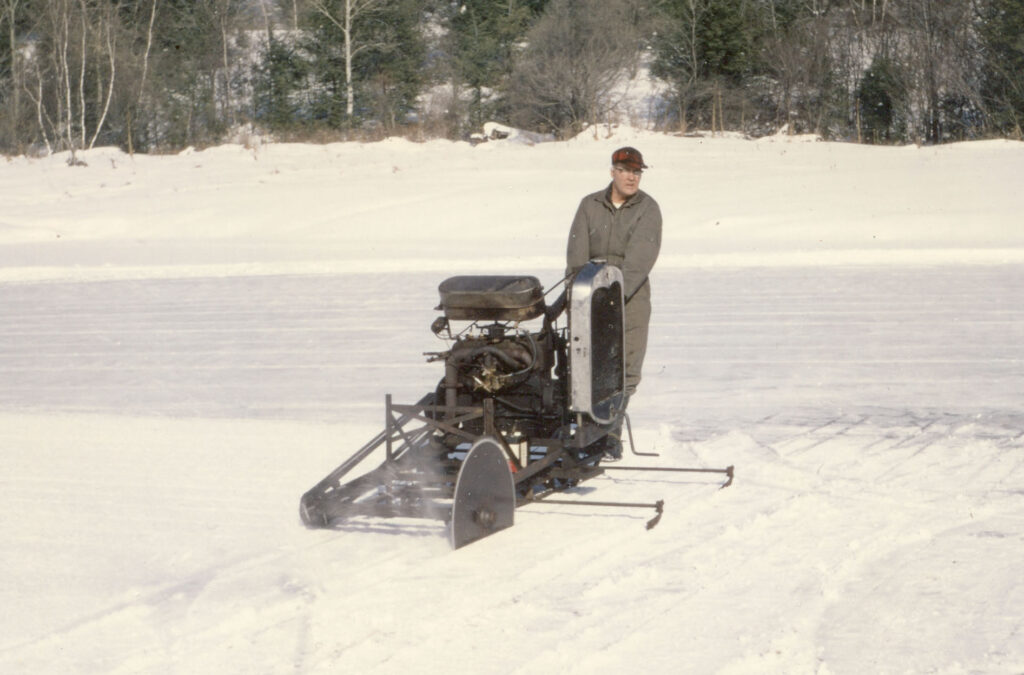
Max Hazelton is operating the ice machine that he built using the engine of a Model A. To begin the process, Dad snapped a chalk line to mark the ice field. He only needed to mark out the first two lines, at right angles. He then followed a line with the ice machine to make the first cut. Dad rocked the machine to push the saw blade into the ice, and when it first cut in, the spray of snow and ice crystals would shoot 20 feet into the air. Once the blade was down, he pulled the T-shaped handle to make sure the guide stayed in the previous cut. The spray of ice crystals did not make it to the surface when the blade was down. Dad would cut to within a few inches of the total thickness of the ice. Cutting all the way through would have created a hazard for the workers.
The ice machine had two rods protruding from the side with small triangular mowing machine blades welded onto the ends. The blades were dropped into the previous cut to guide the width of the next cut. When Dad reached the end of the cut, he rocked the machine to raise the saw—the blades were on a lever and also came up—and pushed the machine back to the starting point, making sure to stay on solid ice. The machine was on runners and had a pivot in front so he could turn it. He would maneuver the machine and drop the blades into the previous cut so the cakes would be all the same width. I recall that he made the narrow 12-inch cuts first. To make the next series of cuts at right angles to the first ones, he adjusted the rods to 24 inches and repeated the same process. When he was done cutting a field, he could still walk on it because the cakes were still attached at the bottom. A field would yield about sixty 12 x 24-inch cakes.
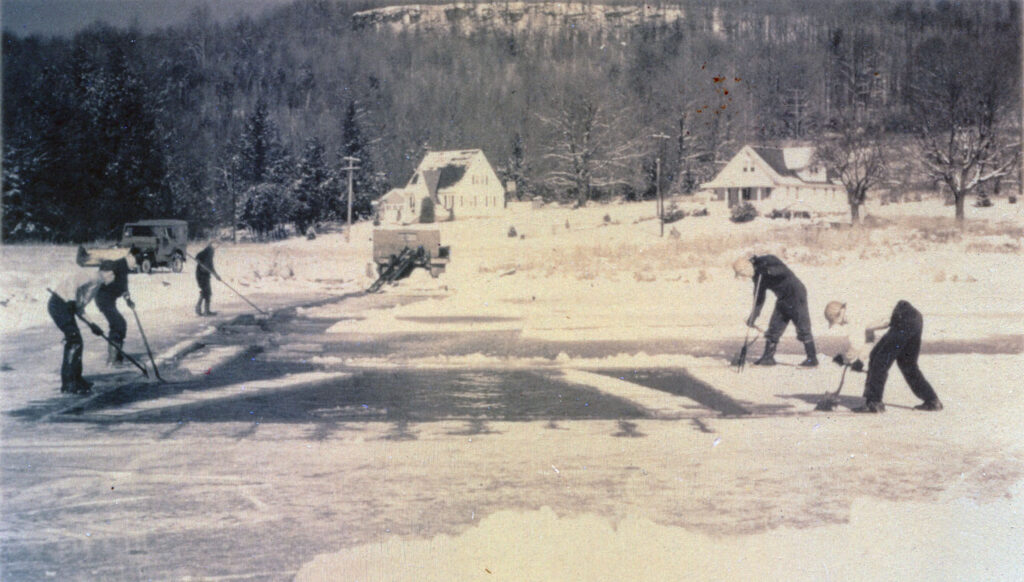
The next step is to create floats, which are rows of cakes that have been detached from the ice field. In order to move a float from the field to the channel, a cake had to be removed from the ends. Following the grooves made by the ice machine, Max and one of his helpers (at left) are using a handsaw to cut throughthe last few inches so they can remove the end cakes. They then take spud bars and go along the edge and hit it here and here and here simultaneously until the whole float breaks away from the ice field. The float is maneuvered across the open water to workers who will use spud bars to separate the cakes and pike poles to maneuver them into the channel. Soon the operation will shift to loading the truck.
This picture must have been taken during the Christmas break, probably around 1957 or 58 when Dad’s helpers were teenagers—Larry and Roy McLain, Tom Peifer and me—I’m the furthest down the channel with that long pike pole that I liked. Most of the pike poles were 6 to 8 feet, but there was one with a long reach, maybe 14 feet, that came in handy. On the far side of the open water, the cut from the previous day has frozen over during the night and looks to be only a very thin covering. Once ice was cut from an area it was definitely off limits. When a new field was to be cut with the ice machine a buffer of several feet was left to the open water of the previous field. Being too close to open water could be a cold bath for someone, or the ice machine. That water was every bit as cold as it looks. My dad fell in twice but was immediately pulled out. Another time a worker fell in, but over his many years of cutting, and as dangerous as it was, I think those were the only accidents.
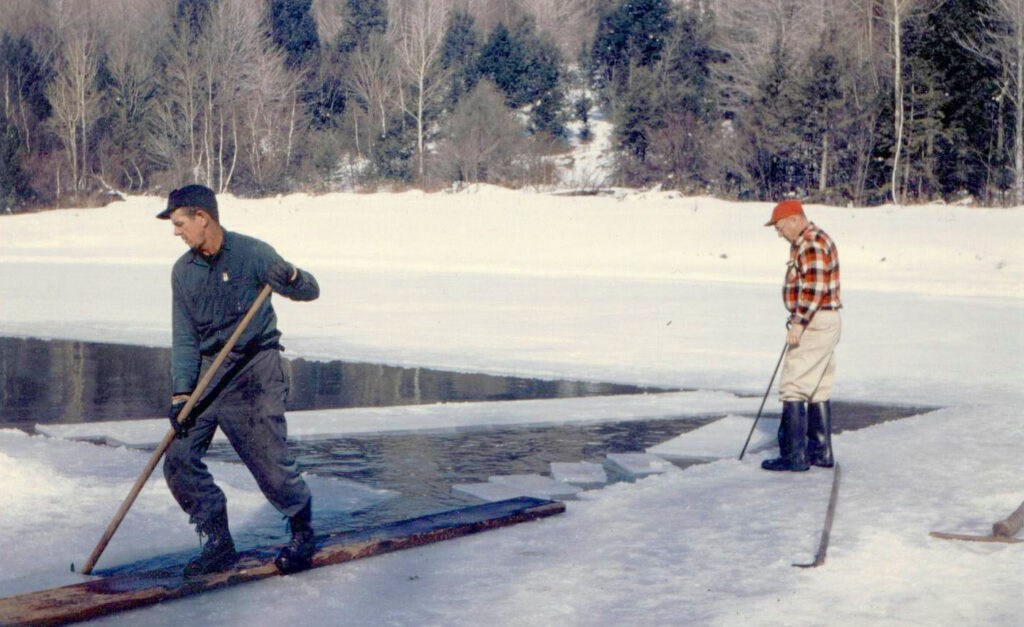
Sam Green and Bill Sowden are breaking off the cakes with the spud bar. The sides of the channel would get worn and slippery after a day or two so Dad would shore it up with planks for traction and safety and to keep the cakes in line on their way to the conveyor.
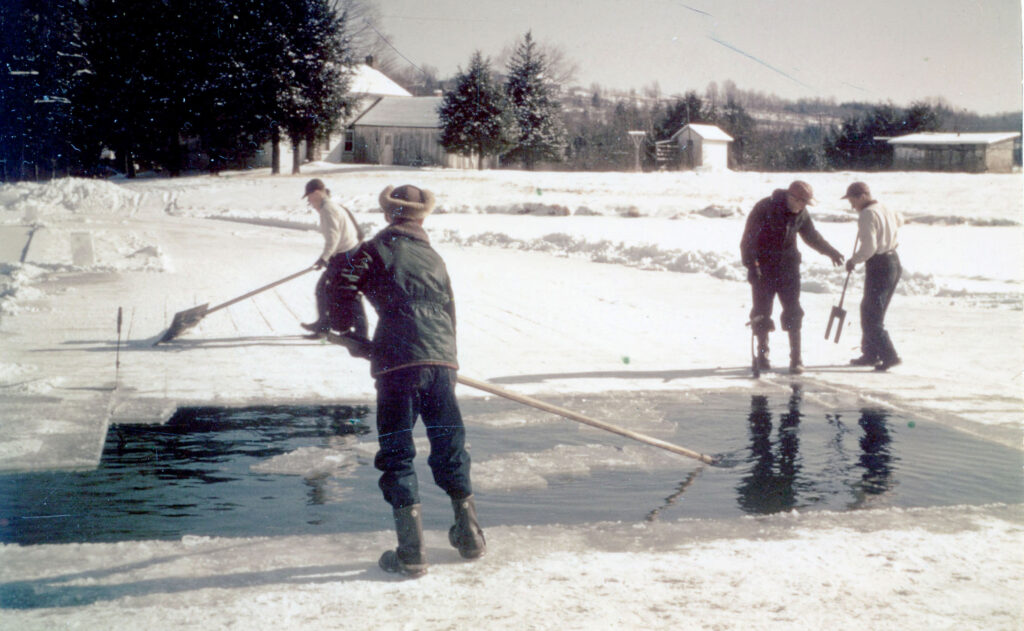
Max is givingLarry McLain (right) tips on using a two-pronged spud bar to break off a float. I am in the foreground guiding cakes into the channel, and the two boys beyond me are pushing the scraper to remove snow from the ice field next to be cut. Two saws are in place along each end of the field. Nina Hopp’s house and outbuildings in the background are long since gone.
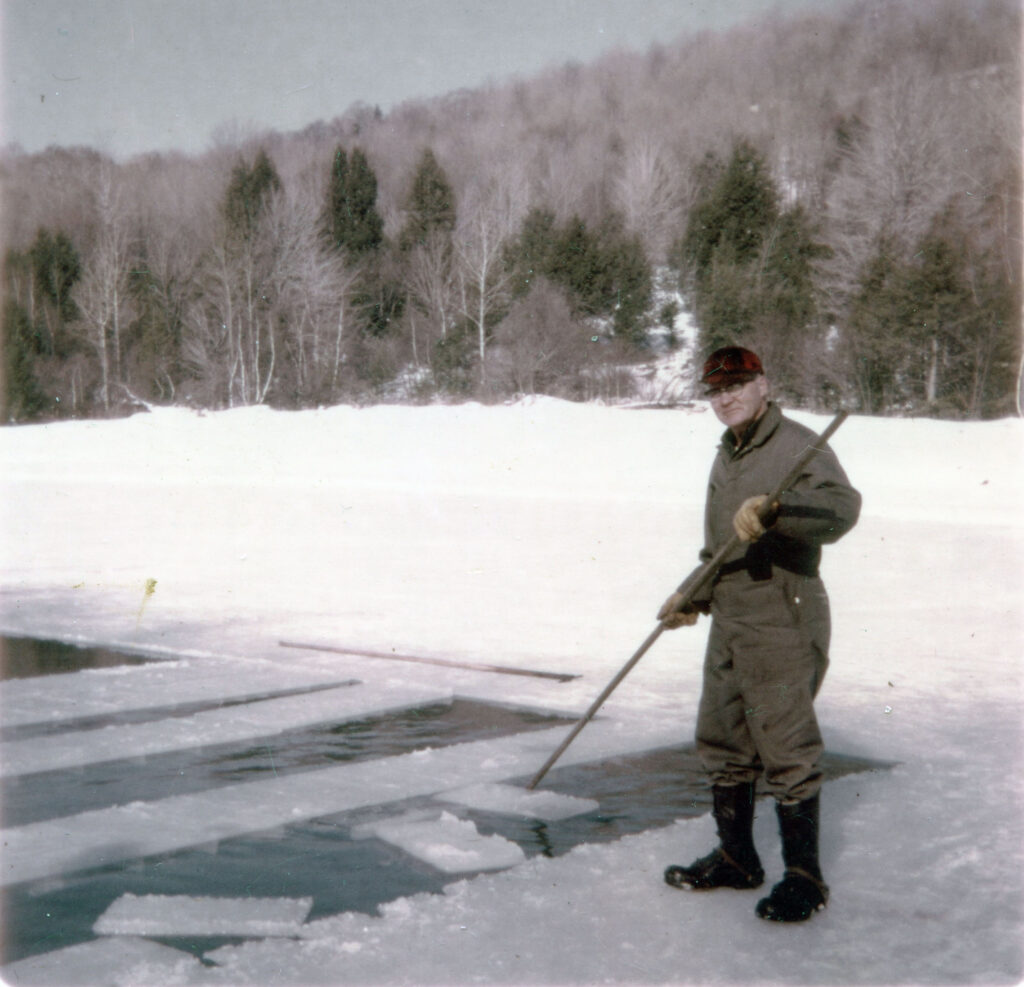
Max is using a pike pole to line up the cakes before entering the channel toward the conveyor. The floats beyond the cakes have not been broken apart yet. He is wearing metal creepers which strap on to his boots to get traction on the ice.
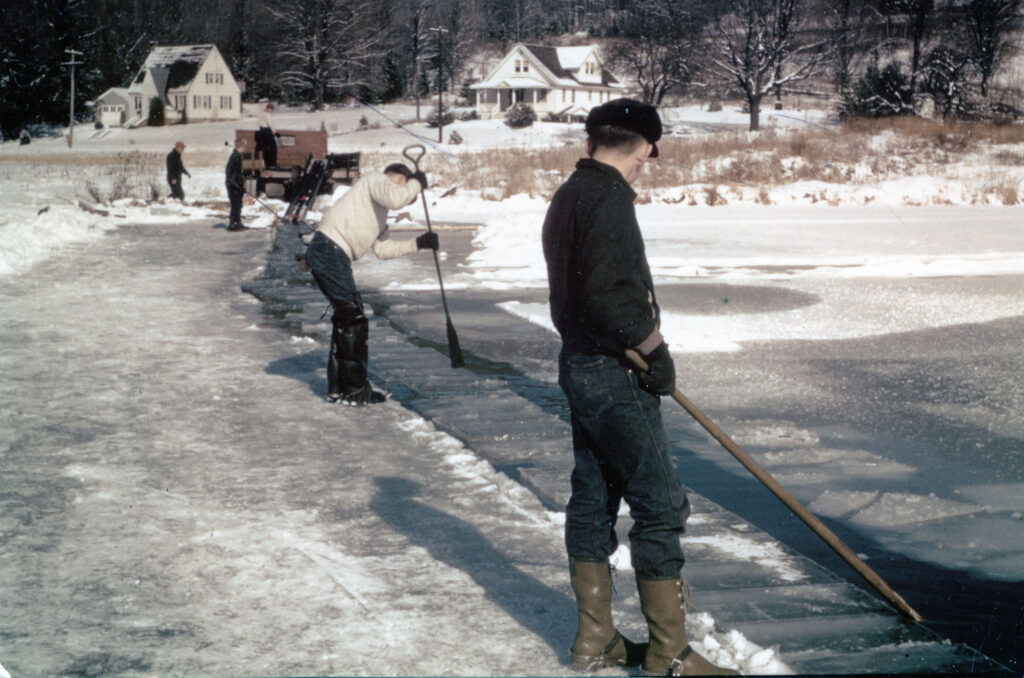
The truck is empty but the ice is on its way. In the background on the far left, Max is about to start the conveyor engine for loading the truck. Tom Peifer (in foreground) is holding a float against the channel wall and feeding it to one of the McLain boys who is using a spud bar to break off the cakes. The worker next to him is loading the channel using a pike pole for maneuvering the cakes. As the channel narrows, each cake is rotated 90 degrees so the narrow end enters the conveyor. I’m standing near the conveyor and rotating the cakes before they enter the conveyor. If no one was up in the truck, the channel would be blocked off with a 2×4 so the cakes couldn’t start up the chute.
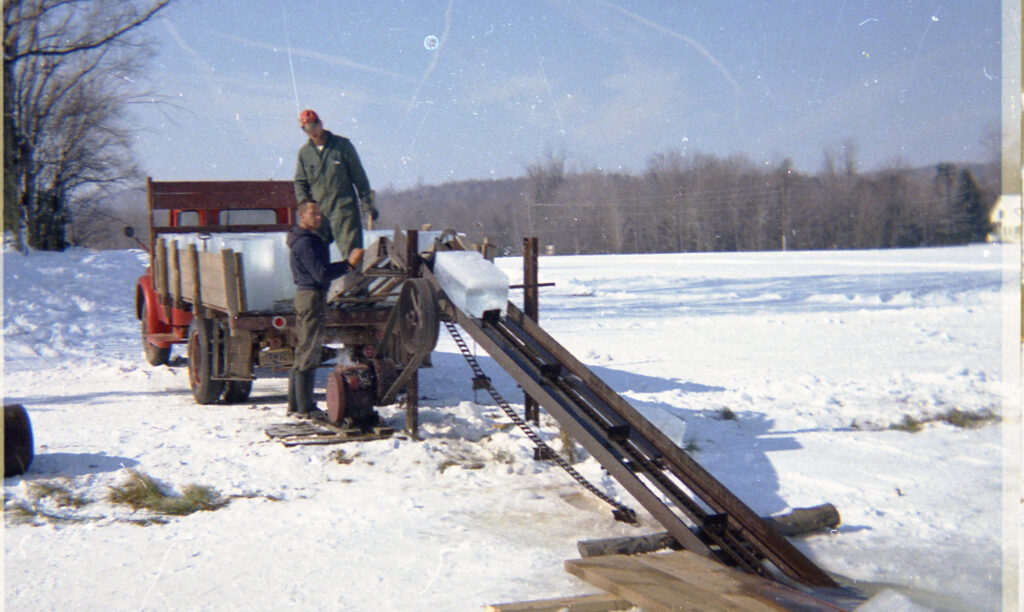
This is a good look at ice going up the conveyor. It was angle iron and extended three or four feet into the water at a depth of about 18 inches. The spacing of the cakes seems about right for the two men on the truck to keep up with. The engine that powered the belt drive is on the ground on some planks to the left of the conveyor. Two vertical I-beams were sunk into the ground near the pond edge to support the conveyor, and they were left there all year around.

Bill Sowden is steering cakes on to the conveyor for loading Willard Croft’s Truck. Bill had to push each cake so it got caught squarely on one of the dogs of the chain. A lot could go wrong here. In this photo there are too many ice cakes on the truck, which can be dangerous. Once a cake got to the top of the conveyor, gravity would take over and the guys packing the truck had better be ready to grab it with the ice tongs. If they missed, about 120 pounds would be heading toward them. If it smacked into the other cakes the ice could break and then it would be dumped over the side. Bill is watching that the packer is doing ok and, if not, he would hold up putting more cakes on the chute. It looks like only one guy is on the truck and he has not pulled the cakes vertically to pack them. Bill seems to be keeping the conveyor full, maybe a little too full. I would be curious if the next few minutes were a bit tense.
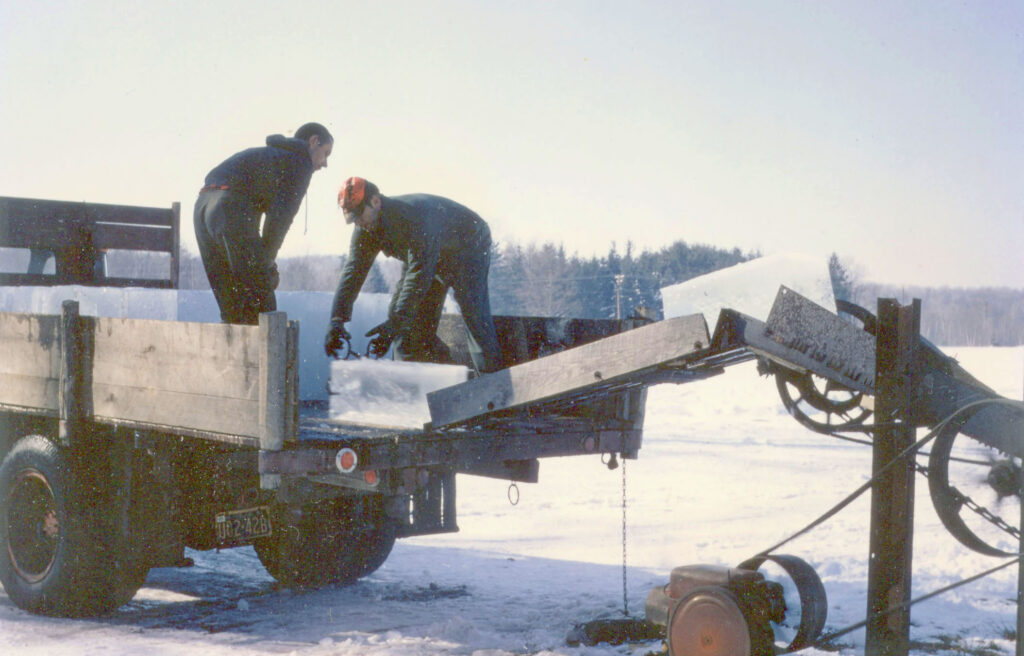
Two men are packing the ice cakes on the bed of the truck; the man on the left is Pete Botjer. The man on the right is grabbing a cake to lift it upright; he needs to be quick as another one is coming up just seconds behind it. They are using ice tongs to grab hold of each cake as it comes off the conveyor and flip it on its end to pack vertically. A few more cakes and the truck will be full.
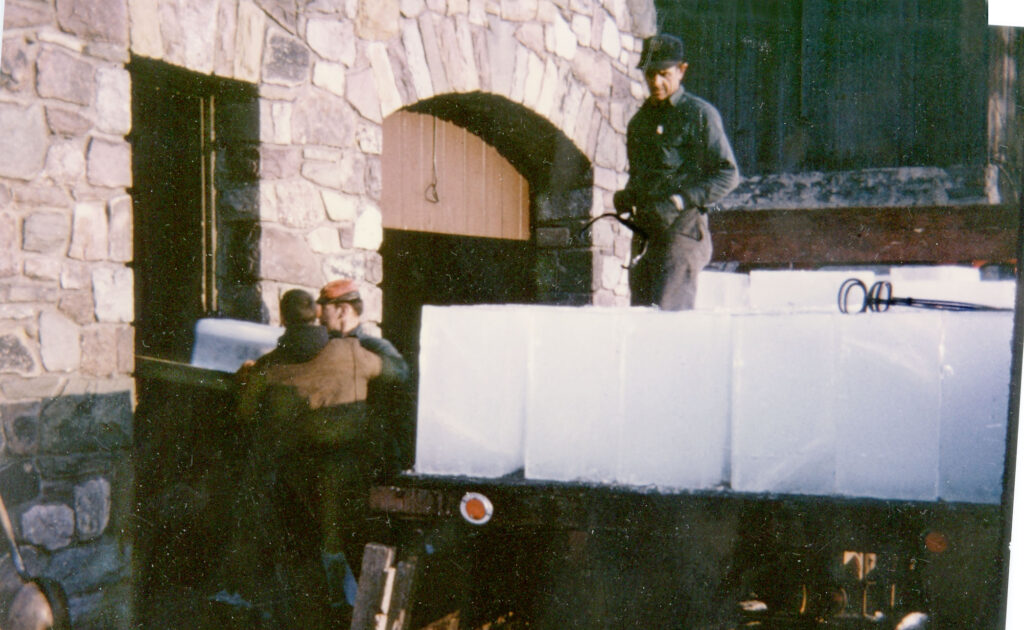
Sam Green is unloading the truck at the ice house. This was early in the season and they are unloading at road level. When you first started out, the cakes would slide down the wooden chute and someone would stand there with rubber gloves on—you had to be careful you didn’t hit anybody. As the layers got higher and higher, you’d have to push them up the chute. When they got to the top of the door, they closed that level off and drove around to the back, which was one
story up. and continued filling it from the top of the hill.
The icehouse had two rooms, one side for ice and the other was the storage area for the tools and ice machine. The garage door on the right was intended for my uncle Dick Hazelton to park his school bus. Although there were windows on the second level, they were boarded over on the inside during the ice harvesting years. When full, the building held about 100 tons of ice. The floor was wood and the ice cakes were stacked in alternating layers, with only a little sawdust spread between the layers. There was a 12-inch gap along the exterior walls and that was packed with sawdust. More than a foot of sawdust was spread over the top layer. Nothing was disturbed until it got hot enough in the spring to get a pickup truck load of ice from the “big icehouse” to sell at the “little icehouse” next to the service station.
The Big Icehouse and the Little Icehouse
Dad sold ice from a little icehouse next to his service station. The building had three sections: The back part had a roof and open sides and contained the refrigeration unit. The middle section was the storage area for the ice that we would bring down from the big icehouse, and it had the cooling coils from the refrigeration unit. The access door from the front “retail” section was well insulated and always kept closed. The retail part was about 7 feet wide and 5 feet deep, and it had the scales, tongs, ice picks, and the saw that we used to cut the ice to the size block the customer wanted—25 to 35 pounds was the most common. Most people had no idea how many pounds they wanted. We would drag out a block that may have been left over from a previous sale and say, “Well that’s about 30 pounds.” Then we would go from there.
Dad sold it for a penny a pound. Later, as I recall it was 1.5 cents per pound. He could estimate the weight quite well, make the cut, and hit it within a pound. Some people wanted it chopped up, which we did with an ice pick in a bucket, and poured into their ice chest over their beer or fish. We also used an ice shaver to make ice so fine it was almost snow. Sometimes we just loaded the chunk of ice into their trunk, and they laid blankets over it and off they went.
I spent most of my summers until college hauling ice to my dad’s service station to be sold—we could sell a full pickup truckload on a hot summer day. So often the first thing on a Saturday morning was for me to get a load of ice from the big ice house. A significant part of the effort was shoveling the sawdust out of the way—it was damp and heavy—and then after the ice was dug out, shoveling the sawdust back on top. The cakes were stuck together, but a well-placed spud bar would break them apart. The sawdust had to be washed off with a garden hose at the big ice house and then again at the little ice house before it was sold.
Dad sold ice to Edgar Wilson who had a store back in Promised Land. Edgar would phone ahead, which gave me a head start in removing the sawdust, and I’d be ready to load up his pickup when he arrived. He would use a tarp to keep the sun from eating into the profits on the drive back to Promised Land. Edgar had his own small icehouse and sold it to campers.
There was at least one year when my dad ran out of ice before the summer was over, which in those days was keyed on Labor Day weekend. He had artificial ice trucked in from the Scranton area. What Dad cut out of the pond he called natural ice, and what they made using refrigeration he called artificial ice. The artificial ice was delivered in very large blocks on the order of 300 pounds. The cakes were hollow, no doubt a result of the technique they used to freeze it. It would crumble when it got too warm, unlike natural ice which melts. It didn’t seem to last as long either. One would think that ice would be ice, but that was not the case.